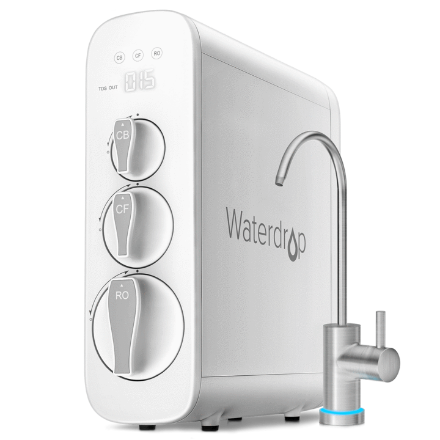What organic and inorganic contaminants should be filtered out of water? What are the differences and how are they gonna effect my health? How can I remove them from my tap water? Waterdrop is here to answer your questions.
Table of Contents
Everyone probably knows that contaminants are present in water. The pesticides, Arsenics, Mercury, and Chlorines, of this world are not entirely new to us. But what most of us do not know is that they belong to two of most confusing types of water contaminant—the organic and inorganic contaminants. The categorization, according to scientists, is necessary to facilitate how to find effective ways of combating them.
This post will discuss these groups of contaminants extensively, particularly the health issues associated and how to get rid of them.
Contaminant types should be filtered
Inorganic contaminants
Inorganic contaminants comprise majorly of toxic metals and minerals. They occur naturally as elements – magnesium and calcium – and are present in water supplies. Other times, they may be present as a result of human activities – mining, agriculture, and industrial processes. There are inorganic contaminants that find their ways into water supplies through pipes – lead, copper, and arsenic, and they can be lethal in some cases. Other inorganic contaminants include Nitrite, Mercury, Chromium, and Cadmium.
Organic contaminants
Organic means natural. As strange as it may sound, the fact remains the most dangerous water contaminants out there are naturally occurring. They are categorized as organic because they are carbon-based, i.e., they come from petroleum. Being carbon-based makes it simpler for them to bind with the human tissue. Hence, they are deadly even in minute quantities. Examples of organic contaminants include pesticides, surfactants, petroleum and phenolic compounds, pharmaceuticals, and dyes.
Associated health risks explained
Most people are unaware of the health implications of these contaminants, especially when they are present in quantities above the Maximum Contaminant Levels. This may lead to problems in the nervous, gastrointestinal, and circulatory systems; the kidney and liver; and the skin and bones. Pregnant women and infants are at higher risks in all cases.
So here are few of the common contaminants of drinking water, and their effect on health:
What are the effects of petroleum?
Skin irritation is the first on the list of health risks posed by petroleum contaminants. Others include issues with the nervous system, and defects in the kidney and blood system, especially when there is excessive absorption of these contaminants through the skin.
What are the effects of pesticides?
Pesticides can cause mild to severe damages to different internal organs. The extent is dependent on the level of exposure.
What are the effects of pharmaceuticals?
Pharmaceutical contaminants in water may lead to severe health issues, considering the capabilities of these compounds to act synergistically.
What are the effects of Arsenic?
The high toxicity of the inorganic form of Arsenic means it can cause skin cancer. The lungs and bladder may be permanently damage on prolonged exposure to Arsenic.
What are the effects of Lead?
The effects differ across various age groups. In the case of adults, exposure to Lead can cause hypertension, increased blood pressure, and cardiovascular issues. For kids and infants, even low exposure to Lead can cause a systematic damage of the peripheral and central nervous systems. The long-term effects of this include impaired formation and functioning of blood cells, impaired hearing and speech production, shorter stature, and different forms of learning disabilities.
What are the effects of Cadmium?
According to the Environmental Protection Agency, Cadmium is a known cause of nausea, muscle cramps, liver injury, renal failure, convulsions, sensory inconsistencies, and liver injury among others. This only happens when Cadmium is present in quantities above the Maximum Contaminant Levels.
What are the effects of Chromium?
The tap water supplying up to 200 million Americans in 50 states of the country contains Chromium-6 in quantities above the MCL. Chromium-6 is a verified cause of cancer, based on a recent scientific research.
Getting rid of contaminants
Now that we have established the deadliness of these organic and inorganic contaminants, it is only normal that we propose a viable solution. Fortunately, all the contaminants mentioned above can be removed from water via
Reverse Osmosis water filtration system.
What are the benefits of reverse osmosis water?
This is a process that forces the water molecules through a special membrane—RO membrane. This membrane is designed to block the larger ions of the water molecules – the chromium, lead, and iron ions. The pressure of reverse osmosis water system thrives on the application of pressure to water. The pressure propels the water while the membrane withholds organic matter, inorganic salt, heavy metals, viruses, bacteria, and other contaminants. The part of water that passes through the membrane is the filtered water, which is free of contaminants. The blocked part is the unfiltered water.
When you buy and install this under-sink water filter system, you can rest assured that it will remove most contaminants in tap water – both organic and inorganic contaminants, including benzene, lead, formaldehyde, and bisphenol A, among others.
Waterdrop can help you find the right
RO systems for your family if you need some assistance. We will work with you in terms of defining your expectations, needs and of course your ongoing consumption. We encourage you to browse our selection of
refrigerator filters to get an idea of what may be right for you. If you would like more information, you should always feel free to
contact us with any questions or concerns. Our team of professionals is ready to provide you with the answers you need so that you can drink water safely and enjoyably.






























































































